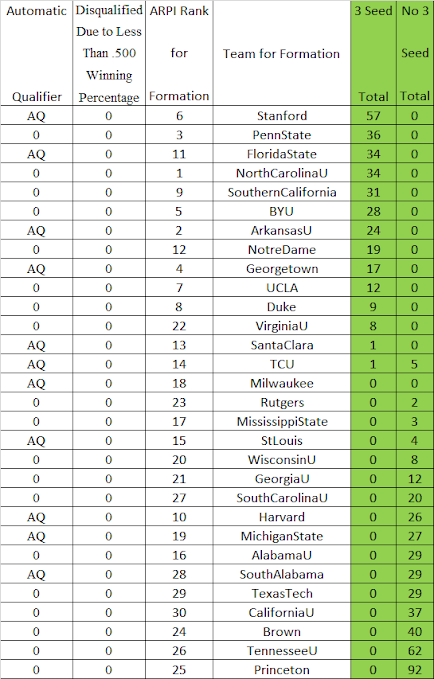This is my third weekly report for the 2023 season. Each week I show:
1. Teams’ simulated ranks using the current NCAA RPI and my Balanced RPI;
2. Based on the current NCAA RPI, teams in candidate pools (expanded) for NCAA Tournament #1, 2, 3, and 4 seeds and for at large selections and where they appear to fit within the pools; and
3. Likely differences in at large selections for the NCAA Tournament if the Women’s Soccer Committee were to use the Balanced RPI rather than the current NCAA RPI.
The background for the information is in 2023 Reports 1 through 4.
Each week, I replace my simulated results for the previous week with actual results. So this week’s information is based on actual results of games played through Monday, September 4 (Labor Day), and simulated results of games not yet played.
Summarizing the likely differences in at large selections for the NCAA Tournament in changing from the current NCAA RPI to the Balanced RPI, derived from the last table below:
At Large Candidate Teams: 11 teams that are not at large candidates under the current NCAA RPI are candidates under the Balanced RPI. Of these, 4 are from the West, 3 from the South, and 4 from the Middle regions. 9 are from Power 5 conferences and 2 are from other conferences.
No Longer Candidate Teams: 11 teams that are at large candidates (if not Automatic Qualifiers) under the current NCAA RPI are not candidates under the Balanced RPI. Of these, 6 are from the North, 2 are from the South, and 3 are from the Middle regions. All 11 are from non-Power 5 conferences. Of these, all either are Automatic Qualifiers or likely would not get at large selections under the current NCAA RPI.
Selected Teams: 5 teams that likely are not at large selections under the current NCAA RPI likely are at large selections under the Balanced RPI. Of these, 3 are from the West, 1 from the Middle, and 1 from the South regions. All 5 are from Power 5 conferences.
No Longer Selected Teams: 5 teams that likely are at large selections under the current NCAA RPI likely are not at large selections under the Balanced RPI. Of these, 3 are from the North and 2 from the South. All 5 are from mid-majors. Of the 3 North teams likely losing at large selections, 2 fall outside the Balanced RPI candidate pool and 1 stays in the candidate pool but is replaced by a better candidate. Of the 2 South teams likely losing at large selections, both stay in the candidate pool but are replaced by better candidates.
The basic change pattern is that teams dropped from the at large candidate pool either are Automatic Qualifiers or likely are not at large selections under the current RPI, so they are not hurt by a change to the Balanced RPI. But of the teams added to the candidate pool under the Balanced RPI, some likely are at large selections, displacing teams that are at large selections under the current NCAA RPI. Thus the effect of the defects in the current NCAA RPI is to prevent teams that deserve at large selections from even being considered by the Committee, with the result that less deserving teams are getting at large selections.
Simulated Ranks
(ARPI 2015 BPs is the current NCAA RPI; URPI 50 50 SoS Iteration 15 is the Balanced RPI)








If a team ranked #23 ties a higher ranked team #17. Will that hurt the #23 RANKED team?
ReplyDeleteLogically, it slightly should help the #23 ranked team, since it has tied a better ranked team, and it slightly should hurt the #17 ranked team. Given the structure of the current NCAA RPI and its strength of schedule measurement, however, it depends on who the two teams are and whether they are at those ranking levels because of their winning percentage or their strength of schedule or a combination of both.
ReplyDeleteFor a simple test, I used the 2022 season and added a non-conference game between #17 Northwestern and #23 Rutgers.
Without the added game, #17 Northwestern had an NCAA RPI rating of .6271. With the added game, its rating became .6292, a slight improvement, and its rating became #16. Of course, the way the RPI is calculated, every game affects every other team, but it nevertheless is an odd change since Northwestern improved its RPI profile by tying a supposedly weaker opponent.
Without the game, #23 Rutgers had an RPI rating of .6083. With the added game, its rating improved to .6108 and its rank improved to #22. This is as expected.
Overall, in most cases I would expect little change for either team.